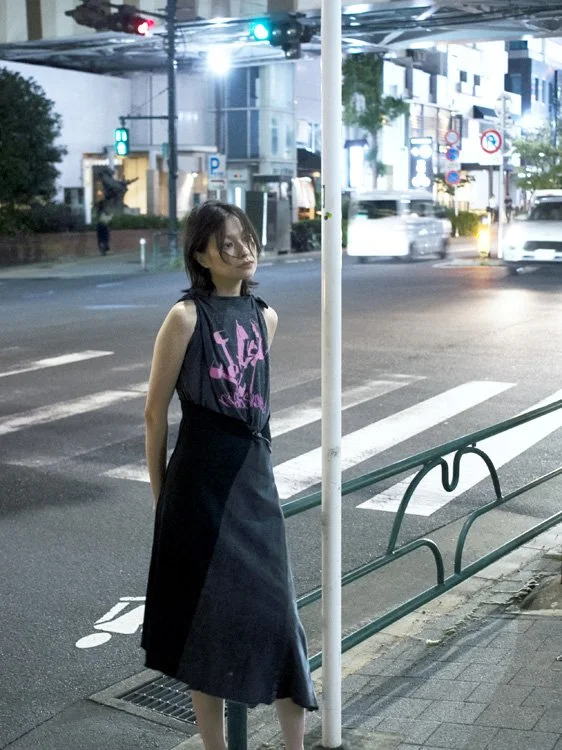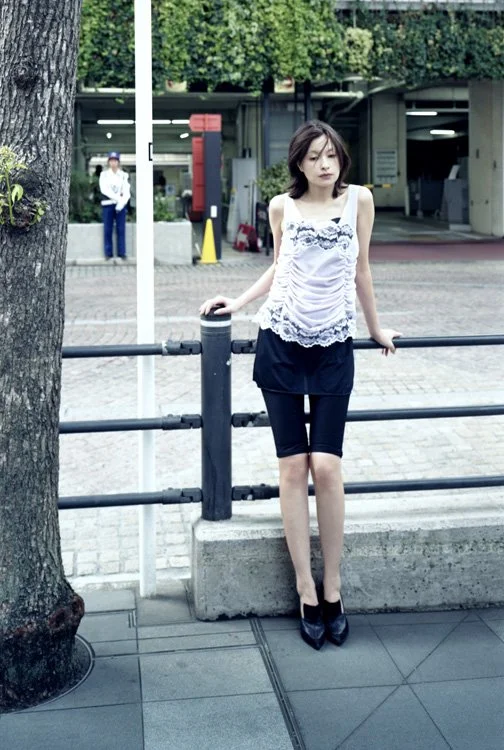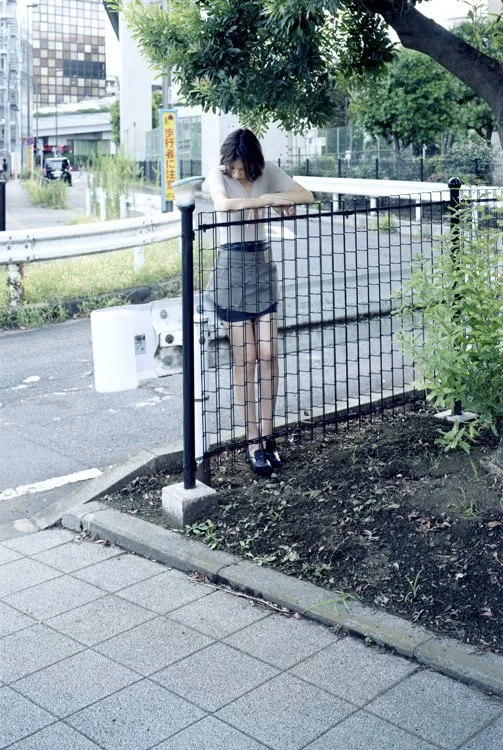NICKLAS SKOVGAARD
ART DIRECTOR KEVIN PFAFF, AMGMT
PHOTOGRAPHER SHOTA KONO
STYLING RIO HASHIMOTO
MODEL RINA OHTA, ASIA CROSS
HAIR ARTIST WAKA ADAICHI, EIGHT PEACE
MAKE-UP ARTIST KAZUHIRO TAKENAKA
CASTING DIRECTOR MISAKI IMAMURA
A BALLOON SKIRT CRAFTED IN QUILTED METALLIC FABRIC, A MINIDRESS MADE UP OF VINTAGE NIGHT GOWNS. PUFFED SHOULDERS, PADDED HEMLINES. BOLD 80S CLUB COLORS, SET AGAINST MUTED PASTEL FLORALS THAT COULD BE HUNG AS CURTAINS IN A 70S HOUSEHOLD. STEEPED IN REFERENCES, DECIDEDLY CHIC, AND ALWAYS WEARABLE. THIS IS THE WORLD OF NICKLAS SKOVGAARD, A DANISH DESIGNER WHO’S EVER-EVOLVING VISION EXISTS PERFECTLY WITHIN HIS DECIDEDLY DISTINCT VISION.
How was Paris for you? How was the energy? It’s such an interesting season to have gone.
There was a lot going on with all the debuts, you could really feel it. It was really interesting, but a lot to take in and digest. We did a performance in Dover Street Market, who we’re working with, and that was super nice.
Oh, amazing, who was the performance artist?
She’s called Britt Liberg. I did my first show here in Copenhagen with her two years ago, and we’ve been working together ever since, on all the shows, and also projects in between. We did a seven-hour self-casting of her, where she photographed herself over and over throughout the whole day, and then we printed these images of her. So basically the setup of a casting, but through her own perspective. It was a very long day, but she did very well.
I need to check that out, it sounds incredible. I read a bit about your upbringing on a very small island with only 4000 inhabitants, and I felt a connection to that, as I grew up in a tiny fishing village on the West Coast of South Africa, and to get access to magazines like Vogue required a journey to Cape Town, and at times even to the airport. I still draw from that sense of restriction and fantasy a lot in my work today. How did your upbringing influence your sense and perspective of creativity and fashion?
I think it influenced me a lot, actually. I think especially within the past years of seeing the brand growing, and also growing more into the identity of the brand. I think I see so much of my upbringing in my work and in my ways of thinking about fashion, especially growing up in a small community during the millennium. When I was a teenager, you couldn’t buy a fashion magazine in the local supermarket; you also had to go to bigger cities. In a way, it’s almost a cliche in fashion, being excluded from something. But then what also happened during that time for me was that all of the blogs started coming out, like Blogspot and WordPress and all of these different media platforms where you could all of a sudden see people from all over the world sharing their outfits and sharing their ideas on on fashion and the collections and what they were wearing and what they were listening to.
For me, it was really an eye-opener into this world where fashion sort of became more democratic. It felt like all of a sudden, it was more available to everyone. You could find all of the past show videos on Google, YouTube, style.com. Fashion became more open. This really shaped my idea back then of wanting to work in fashion, and sharing my own thoughts. I also ran a blog back then, when I was like 13 / 14, where I was sharing what I was wearing and what collections I liked, I was sewing some pieces that I would also share through the blog. That really helped shape my idea that I could also fit into the fashion industry, because it felt like everyone could fit all of the sudden. I sometimes feel like I have this almost naive way of thinking of fashion, which I think is very much shaped by this idea of seeing it through those early blog days.
Do you remember your favourite blogs? Style Rookie changed my life, in terms of looking at fashion and connecting them with movies or even your own personal experience.
Yeah. I loved her too. She was also around when I had the blog, which was one of the first blogs to come up in Denmark at that time. I was one of the first bloggers who was ever invited to Fashion Week here in Copenhagen. There was a lot of media coverage of my work back then, and the Danish broadcast company did this documentary about my work, and they called me the Danish Style Rookie.
A friend of mine from South Africa made this backpack out of tapestry material and sent it to Tavi, and she actually wore it and styled it on her blog. And it was the biggest moment ever for us. I see a lot of pop culture references in your clothing universe-John Waters, The Virgin Suicides, Picnic at Hanging Rock, Sixteen Candles all come to mind. What are your reference points? How were you introduced to them?
I would say they are a mix of being quite pop cultural, and then also ranging from very historic references, because I’m really into history, and love reading old books and watching old documentaries about Danish history. It’s very much a mix of both, I would say. The pop cultural reference points come from being a child, and watching Marie Antoinette for the first time, or even The September Issue. Finding, for example, the work of Sofia Coppola, which I think really shaped so many of my ideas on how to build a character. And this very hard-driven storytelling, which I think speaks so much to me, because I really want to be a part of this universe, where I hope that when people see my clothes, that they get this full 360-idea of the brand. They don’t just see a jacket, but the person wearing it, and the kind of music they would listen to, or books they would read, or restaurants they would go to in this jacket. And I think for me, that is really the essence of fashion, when you’re able to create that universe and that energy around a piece of clothing. I think it adds so much value. Some would say it’s just a garment, but for me, it holds so many emotions and feelings even though it’s just a jacket. And I think it’s very much the same ideas that shaped me in terms of these pop culture elements. You want to be a part of it, even though it’s something you might imagine in your head. And I really try to sort of take that out and put it into my own world.
I think that’s something that you do very well, and I can see the connection to Sofia Coppola and how she creates worlds. Like in the Virgin Suicides, for example, the detail that goes into the girl’s bedroom, so that you completely understand their secrets, their interests. What I really admire about your designs is that while they are definitely leaning towards the avant-garde, it’s also so wearable. It makes me think of the woman I want to be, and to create occasions -and a life- around the garments. Past or present, who is your dream woman to be photographed wearing Nicklas Skovgaard?
I think the honest answer for me is seeing Madonna wearing the brand at some point. I’m actually even wearing a Madonna T-shirt today. I also have a very strong memory of listening to American Life in 2000; my dad bought it, and we played it in his car. You really get the identity of her work, just from listening to it and seeing her artwork and seeing her music videos. She’s a big reference point for me still, every season I have a specific Madonna album that I listen to a lot in the studio, and I find something. It’s not necessarily like a specific inspiration, but it might be more like a mood. And I think what’s really interesting about her is how with every new album, she sort of changes her identity. I’m so excited to see how Confessions of a Dance Floor Part Two will look like, because I have a very strong memory of Confessions of a Dance Floor, and what it looked like and its late 70s disco style. I think I would really love to see her at one point wearing the brand. I think that would really be like a dream come true moment.
There’s definitely a different Madonna for every mood of your life. Scandinavian fashion and design have a reputation for being quite minimalist in shape, silhouette, colour palette, very clean. Your designs and your shows at Copenhagen Fashion Week feel completely opposite to this notion of “Scandi style.” How has the reaction been to this?
I still remember when I was about to do my first show, like two years ago, which was the first time that I was showing the collection in real life here in Copenhagen. I was very nervous before that show, because it was the first one, but also because I felt like the collection stood out from a lot of the other brands at Fashion Week, where some of them might feel more commercial or more like the “Copenhagen style”. And I remember back then, there were a lot of mixed emotions from the people who came and saw it. There was a lot of international media that really understood the concept and understood the vibe of the brand. And then there was definitely some Danish media who were more like, What is going on here. We don’t really get it. It’s been interesting to watch, for the past four or five seasons, how it’s changed in Denmark. The media, all of a sudden, started to get my ideas. I think it’s also just because it might have felt different back then from what other brands were doing in Copenhagen, and also, what was the “Copenhagen” or the “Scandi” style?
And with Danish or Scandinavian style in general, is there something you wish people knew? Or an era you wished people knew about?
I think it’s interesting when we talk about this Scandi style, because it’s fun to think about that. A lot of people have this idea of Scandi style being very minimalist and beige, and all of the things you’re saying which I totally agree with. But I started thinking about this a few years ago, like, what is Scandinavian style? And when you look at the history of Danish brands, a lot of them were much more eclectic. When I go out into the streets of Copenhagen, I don’t only see people wearing beige.
I feel like the idea of Scandi style came up in the past 10, 15 years, but I actually remember as a child seeing Danish brands that felt much more over-the-top, actually. There’s a lot of old brands that were doing the same as I’m doing now. If you just look at our previous queen, Queen Margrethe, she’s super eclectic. She’s always wearing floral and big, colourful gowns. You never really see her wearing black or beige or white. It’s not that I’m a big royalist, but we definitely have something else than just pure minimalism.
Speaking of your space within the Danish design community, you also present things in a very different way, using performance art in fashion shows and such. What is your process when you come up with how you want to present your collection?
I think often it starts with the actual collection first, like the concept of that collection. Let’s say the first show I did, like two years ago, with Britt Liberg, the performance artist I just worked with last week, that collection was inspired by a Danish painter called Gerda Wegener, who was married to a man who then transitioned into a woman. There was actually a movie about it some years ago called The Danish Girl. I saw some of her paintings in a gallery, and she only painted her wife Lili Elbe throughout her whole career, and she was like the ultimate muse of all of her works. And I thought it was so beautiful, this idea of, you know, Lili being portrayed in different phases of her life, wearing different outfits. You really felt that connection in the paintings, I think.
And when I was about to do that first show, I thought it would be really interesting to work with this idea of the ultimate muse. I decided that I only wanted to have one model in the show. And then a few months before this, I saw Britt’s work, who did this performance called ‘A Fashion Show,’ where she tried on 1015 looks throughout 15 minutes in a museum, and she called it a fashion show. I thought it was so interesting to see the way she created characters from what she was putting on. And I think I saw a lot of connection from the works that inspired the collection to the work she did herself. That really shaped that idea of the first show, and I think that’s something that I’ve been continuing with every collection since then, having a very strong concept, and then creating a show around that concept. I somehow have a feeling that a lot of people within fashion are afraid of shows whenever they become too theatrical, or when there’s a lot of emotion. I feel like there’s a thought that you should just be doing a straightforward runway show. And I feel like you have that window to sort of sell the clothes in another way. So that it’s not only about, you know, the jacket. It’s also about the feeling when you go to a show. It’s really about building these strong concepts around the show, and together with the cast, what they feel comfortable with, and also the music and the set of the show. I think it’s just all of these small things that create this feeling like going into a movie, in a way. You almost step into a movie set when you attend a show.
The theme of this issue is Transition. What state of transition do you think the fashion world is finding itself in? And where do you see things going? What does the future of fashion look like to you?
I feel like I’m in a constant transition of going somewhere with the brand or evolving it, that’s also the essence of fashion, somehow. The day fashion stops, or it remains the same, it probably won’t be fashion anymore. I’ve read a lot of like articles about how some people feel that fashion has become less human in a way within the past years. And how in more collections, it’s about the idea of a design rather than actual pieces you can wear. And this actually started a lot of thoughts for myself about my own work. Is it wearable? How do I see people wearing it for everyday? What is the idea behind the work I do, what is the purpose? Should it be worn or should it be hanging in a museum? And obviously, I want it to be worn because I think for me, it’s that idea of giving the feeling that I have when making a piece of clothing to someone else. I don’t want it to just go into a museum. I want it to go into someone’s wardrobe, where they can then give it to someone else.
I hope in some ways that fashion is transitioning into something that feels welcome to all in a way. Like that’s how I felt when I was a child and I saw all of the blogs coming. And when I was invited for Fashion Week, it felt like a very exclusive world that somehow opened up a bit to a child. And I think the same thing also happened with Instagram. And I hope that with all of the things going on in fashion right now, that somehow this humanity will remain. At least for me, it’s really important. We all wear clothes every day and I think if we only design for one type of customer, for a very specific audience that can spend say, 10,000 on a dress. Very few people in the world can actually buy this. And I think at least within my work, which is, of course, still expensive but I try within every collection to think if there is someone at my own age or in my community that could actually be buying this dress ? I think it’s really important that everyone should be able to invest in something. It shouldn’t feel too exclusive.
ALL LOOKS BY NICKLAS SKOVGAARD































